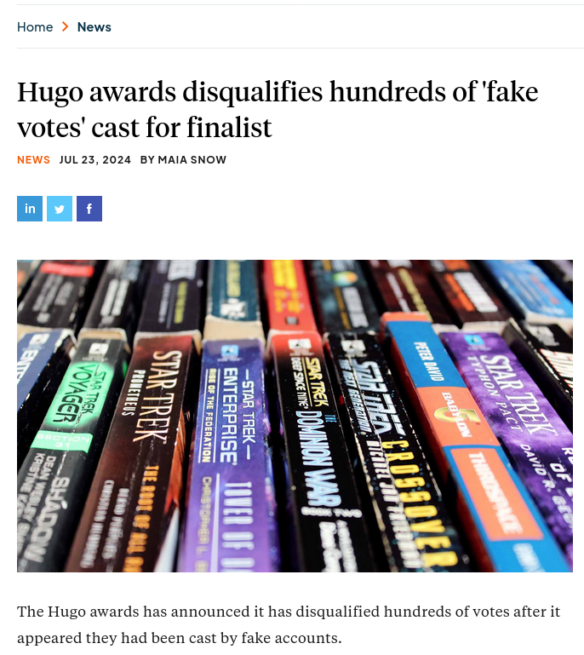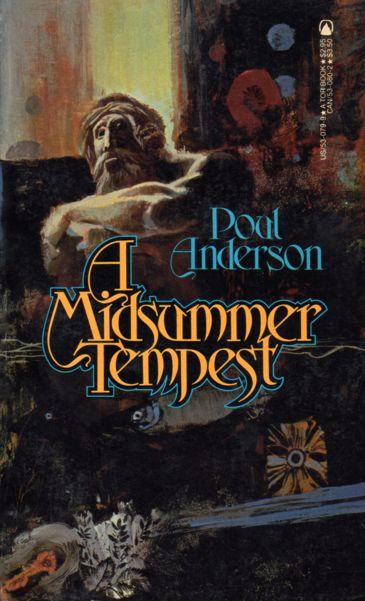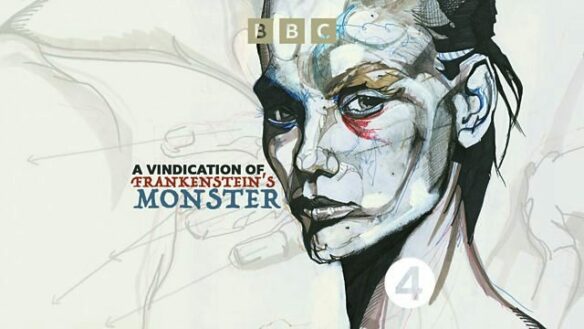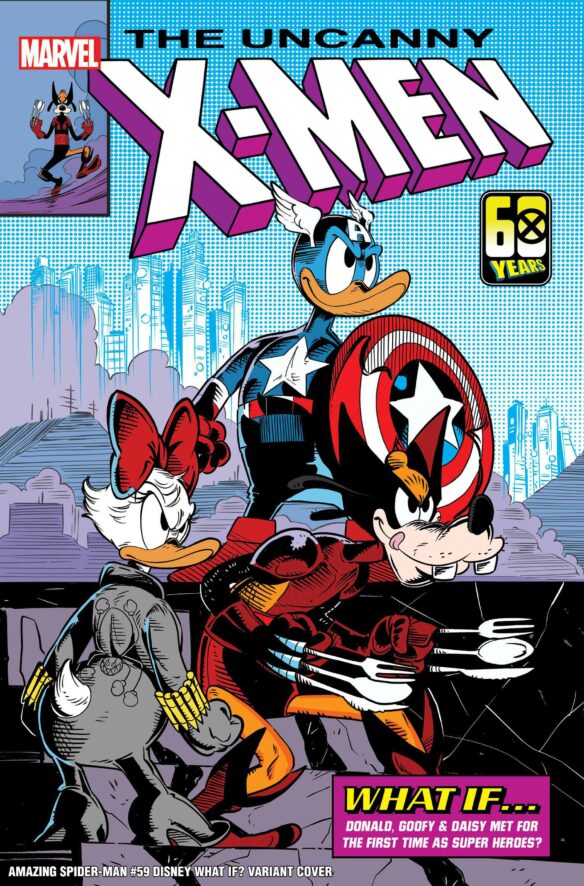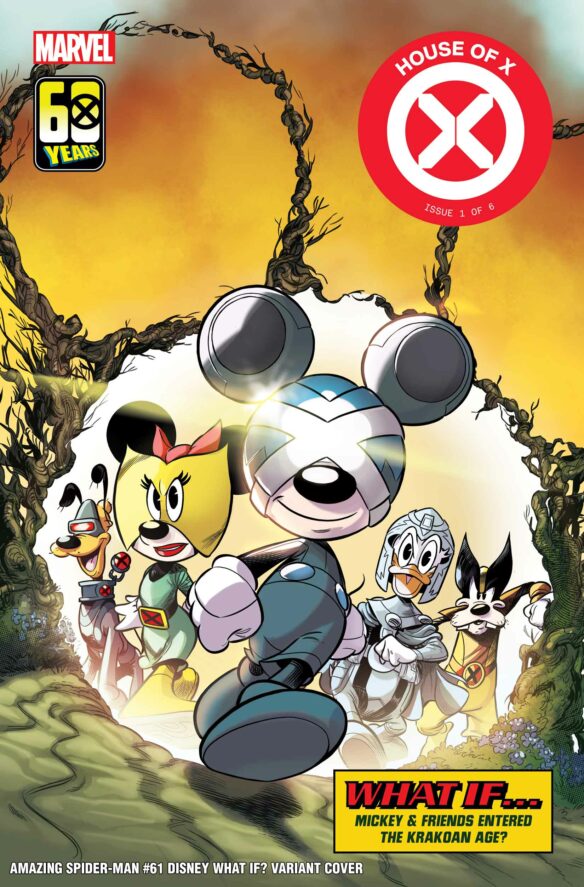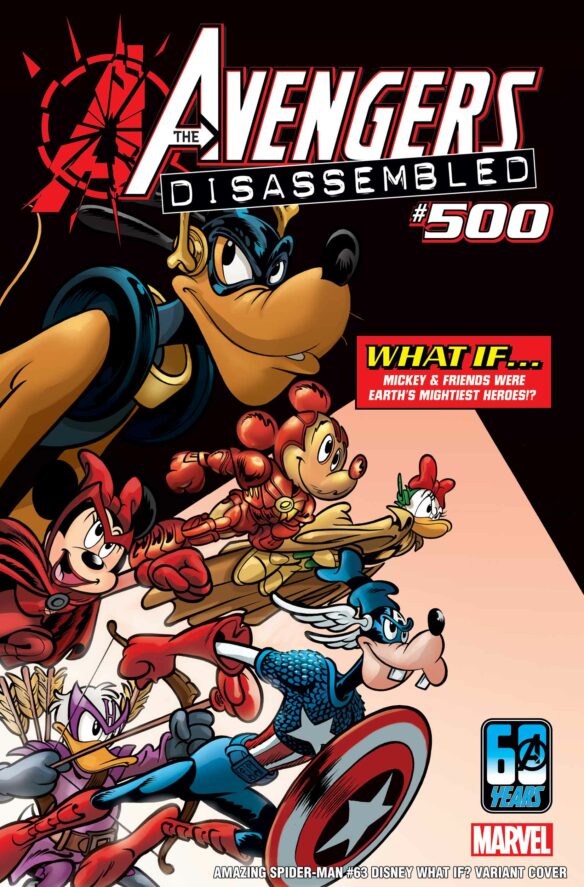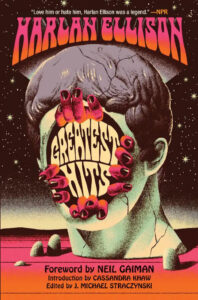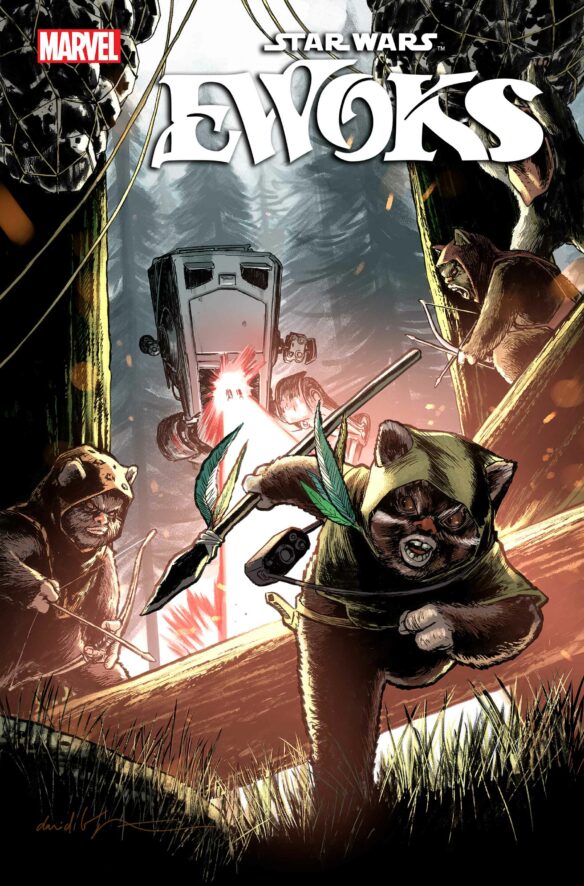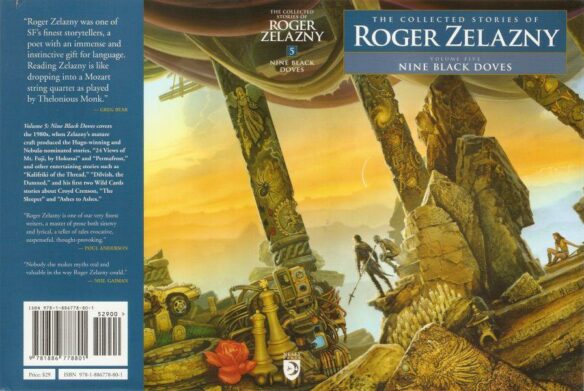(1) CHRIS GARCIA ANALYZES THE AGENDA. In Claims Department 74 – “2024 Business Meeting”, Chris Garcia will be happy to tell you what he thinks about every proposal or amendment up for ratification at Glasgow 2024.
Welcome to another Claims Department, and this one is hella SMoFish, so if you got loins, you might wanna gird them….
There are things Chris is for, things he’s against, even one thing “I’m all the damn hell crap balls of the way for!” There’s another he disapproves of because “It’s clear to me that some people just hate fun”. And one piece of business he writes down with, “It’s garbage.”
However, all the commentary is substantial and well-informed.
The issue also includes a six-page Q&A session with Business Meeting Presiding Officer Jesi Lipp. For example, Lipp says about the items which are going to be confined in an Executive Session:
…I want to clarify a few misunderstandings that I’ve seen. First, if you are an attending member of WSFS, you don’t have to leave the room. Second, the rules around divulging what happens in executive session only apply to non-members. Any member at the meeting is free to discuss what happened with other WSFS members (so long as they do so in a way that does not also divulge the proceedings to non-members) because they also have an interest in the happenings of the society. Third, minutes are still recorded in executive session, they just don’t become a part of the publicly available minutes, but they will be retained and could be read at a future meeting (if that meeting was itself in executive session)…
There is no misunderstanding that the idea is to keep the transactions of the Executive Session from becoming known to the general public.
(2) HUGO BALLOT STORY HAS LEGS. The Worldcon’s announcement covered here as “Glasgow 2024 Disqualifies Fraudulent Hugo Ballots” has been picked up by some mainstream news and popular culture sites:
- CNN: “Hugo Awards: Hundreds of fraudulent votes cast in prestigious science fiction prize”
- The Guardian: “Hugo awards organisers reveal thousands spent on fraudulent votes to help one writer win”
- Polygon: “Someone apparently spent $21,000 to very poorly rig the Hugo Awards”
- Book Riot: “The Hugo Awards Disqualified Hundreds of Votes for One Finalist as Fraudulent”
- The Herald of Scotland: “Fraudulent vote row hits Hugo Awards ahead of Glasgow event”
- Comics Beat: “10% of all ballots cast for the 2024 HUGO AWARDS deemed ‘fraudulent’”
(3) VINTAGE SAFETY. “Can a flight safety video be hilarious?” asks Abigail Reynolds. “Yup, especially if you like Bridgerton, Outlander, Pride & Prejudice, or Downton Abbey!” Will some of you be seeing this en route to the UK and Glasgow? “British Airways | Safety Video 2024 | May We Haveth One’s Attention”.
(4) TOXIC SPINES. “Old books can be loaded with poison. Some collectors love the thrill” – Yahoo! finds literary tastes can be a hazard.
As a graduate student in Laramie, Wyo., in the 1990s, Sarah Mentock spent many weekends hunting for bargains at neighborhood yard sales. On one of those weekends, she spotted “The Lord of the Isles,” a narrative poem set in 14th-century Scotland. Brilliant green with a flowery red and blue design, the clothbound cover of the book – written by “Ivanhoe” author Walter Scott and published in 1815 – intrigued Mentock more than the story.
“It was just so beautiful,” she says. “I had to have it.”
For the next 30 years, “The Lord of the Isles” occupied a conspicuous place on Mentock’s bookshelf, the vivid green sliver of its spine adding a shock of color to her home. Sometimes she’d handle the old book when she dusted or repainted, but mostly she didn’t think too much about it.
Until, that is, she stumbled upon a news article in 2022 about the University of Delaware’s Poison Book Project, which aimed to identify books still in circulation that had been produced using toxic pigments common in Victorian bookbinding. Those include lead, chromium, mercury – and especially arsenic, often used in books with dazzling green covers.
“Huh,” Mentock thought, staring at a photo of one of the toxic green books in the article. “I have a book like that.”
Mentock shipped the book – tripled-wrapped in plastic – to Delaware. It wasn’t long before she heard back. The red contained mercury; the blue contained lead. And the green cover that captivated Mentock all those years ago? Full of arsenic.
“Congratulations,” the email she received said, “you have the dubious honor of sending us the most toxic book yet.”…
(5) ACTORS UNION STRIKES AGAINST TOP VIDEO GAME PUBLISHERS. “SAG-AFTRA Calls Strike Against Major Video Game Publishers” Variety tells why.
SAG-AFTRA will go on strike against major video game publishers, the actors union announced Thursday, following more than a year and half of negotiations, with the main sticking being protections against the use of artificial intelligence.
“Although agreements have been reached on many issues important to SAG-AFTRA members, the employers refuse to plainly affirm, in clear and enforceable language, that they will protect all performers covered by this contract in their A.I. language,” SAG-AFTRA said.
The strike was called by SAG-AFTRA national executive director and chief negotiator Duncan Crabtree-Ireland and the Interactive Media Agreement Negotiating Committee. It will go into effect July 26 at 12:01 a.m….
The video game companies included in the strike are: Activision Productions Inc., Blindlight LLC, Disney Character Voices Inc., Electronic Arts Productions Inc., Formosa Interactive LLC, Insomniac Games Inc., Llama Productions LLC, Take 2 Productions Inc., VoiceWorks Productions Inc., and WB Games Inc….
“We’re not going to consent to a contract that allows companies to abuse A.I. to the detriment of our members,” SAG-AFTRA president Fran Drescher said. “Enough is enough. When these companies get serious about offering an agreement our members can live — and work — with, we will be here, ready to negotiate.”…
(6) WE ARE NOT AT THE SINGULARITY. [Item by SF Concatenation’s Jonathan Cowie.] Nature’s cover story this week “Garbage Out” looks at artificial intelligence. Apparently artificial intelligences (AIs) are really easy to induce to hallucinate if the AIs are trained by computer-generated data. One definition of a Singularity is that it is the point in time in which technology itself creates technology: such as robots building the computers and the computers programming the robots and themselves. Such a singularity was popularized by the mathematician and SF author Vernor Vinge…. The good news from this research is that humans are still key… (For now.)
The explosion in generative artificial intelligence (AI) tools such as large language models has been powered by the vast sets of human-generated data used to train them. As these tools continue to proliferate and their output becomes increasingly available online, it is conceivable that the source of training data could switch to content generated by computers. In this week’s issue, Ilia Shumailov and colleagues investigate the likely consequences of such a shift. The results are not promising. The researchers found that feeding AI-generated data to a model caused subsequent generations of the model to degrade to the point of collapse. In one test, text about medieval architecture was used as the starting point, but by the ninth generation the model output was a list of jackrabbits. The team suggests that training models using AI-generated data is not impossible but that great care must be taken over filtering those data — and that human-generated data will probably still have the edge.
The open access research is here.
(I do warn folk that the machines are taking over, but nobody ever listens…)
(7) DONATE TO DEB GEISLER AWARD. In honor of the late Deb Geisler, who died in March, her husband Mike Benveniste has established the Deb Geisler Award for Journalistic Excellence Fund at Suffolk University (where she taught) “to provide an annual stipend to a deserving student in the Communication, Journalism, & Media Department.”
Donations to the fund can be made online or by check: Link to give online: https://Suffolk.edu/Summa. By mail: Suffolk University, Office of Advancement, 73 Tremont Street, Boston, MA 02108. Attn: Kathy Tricca
(8) TOGETHER FOR A LUNCH “TREK” WITH THE FABULOUS NICK MEYER! [Item by Steve Vertlieb.] Together with the wondrous Nicholas Meyer on July 24, 2024. In addition to having directed the definitive “Star Trek” film … Star Trek: The Wrath of Khan, as well as the last motion picture with the original television crew, Star Trek: The Undiscovered Country, Nick also directed the unforgettable romantic sci-fi fantasy, Time After Time, directed The Day After, the controversial telefilm predicting the devastating consequences of nuclear war, composed the screenplay for Star Trek: The Voyage Home, the teleplay for The Night That Panicked America (concerning Orson Welles radio production of “The War of the Worlds”) and authored The Seven Percent Solution.
He is a brilliant raconteur and conversationalist, as well as a charming and most delightful lunch companion. His newest Sherlock Holmes novel, Sherlock Holmes and the Telegram from Hell, from the Reminiscences of John H. Watson, M.D. is enjoying critical success and brisk sales.
Had the pleasure of chatting with Nick once more on Sunday afternoon following a screening of Star Trek: The Undiscovered Country at the Aero Theater, and spent an absolutely delightful two hours over lunch this afternoon, enjoying more quality time with this sublimely gifted artist who I’m honored to think of as my friend.

(9) SHINING MEMORIES. IndieWire cues up the trailer for Shine On — The Forgotten ‘Shining’ Location”, a new Kubrick documentary.
Few movie sets in Hollywood history have generated more interest than the Overlook Hotel from Stanley Kubrick‘s “The Shining.” The fictional Colorado hotel provides the backdrop for Jack Torrance’s (Jack Nicholson) descent into madness, and Kubrick devotees have spent countless hours analyzing symbolism in the production design and the disorienting effects created by the hotel’s impossible floor plan. The hotel sets, hailed by many as some of the defining craftsmanship of Kubrick’s filmmaking career, now get their moment in the spotlight in a new documentary set to be released on the late director’s birthday.…
…The film will see the collaborators revisiting some of the last remaining studio sets from “The Shining,” which were thought to have been destroyed years ago….
“There have been so many rumors about some of the sets from ‘The Shining’ still existing at Elstree Studios, but to actually find them and walk around them was like discovering a holy grail of film history,” [Paul] King said in a statement announcing the film…
(10) TODAY’S BIRTHDAY.
[Written by Paul Weimer.]
July 25, 1973 — Mur Lafferty, 51.
By Paul Weimer: The Mighty Mur Lafferty, to be truthful. Back in the early days of the modern SFFnal internet, when before even blogs were quite a thing, there was Mur Lafferty, doing audio versions of stories, doing her podcast (I should be writing) and being one of the early adopters and early heralds of the SFFnal internet. I came into the SFFNal internet not long after, and thus discovered her work, and her podcast, just when I was getting my own start in writing reviews and such (this was in 2008 or so). I started with her Afterlife series and followed her career along. In those days, self-published work “didn’t count” for publication, which is why she managed to be a 2013 John C. Campbell Award nominee and then winner (now the Astounding Award) for Best New Writer, which was odd, because I’d been reading her for half a decade.

And it is heartwarming that she remembers me from those early halcyon days.
But besides the Afterlife novellas, and the Shambling Guides, and her fun twitter threads of pretending to watch minor league Baseball in the guise of a lady of Westeros come to North Carolina, I’ve been listening to her podcast, interacting with her on social media, meeting her at cons for a good long time. She’s played the long game in honing her skills, craft and writing abilities. Mur Laffery is simply the embodiment of the “10,000 hours” school of writing, getting better by writing and writing and writing. Mur proves the grind can work.
I think her Midsolar Murders novels (starting with Station Eternity) are probably the best place to begin with her work. I find her voice as a writer quirky, comfortable, and relentlessly entertaining, Although Six Wakes, which really marks the start of her more recent career (and a Hugo finalist) is a good single novel to take the measure of Mur’s work, if you want to try it.
And yes, Mur, yes, as you say, I should be writing. Happy birthday my friend.
(11) COMICS SECTION.
- Broom Hilda exposes the reason behind some shortages.
- The Argyle Sweater features Roman sleep tech.
- Rubes tells the early days of two inventors.
(12) POEM BY ROB THORNTON.
Greenwish
The city blooms
Solar flowers drink life
Unwood towers soar
The city glistens
Buffalo browse in
shade Commuters
step carefully
The city works
Nests of mage-makers
shape great info-dreams
The city pauses
Crowds shimmer
rainbow
Talk lazily in siesta
The city eats
Trini-Hunan tofu
and gorgeous greens
The city sleeps
Inhales waste
Exhales air and water
The city awakes and sighs
“Christ, what an imagination I’ve got.”
(13) WHO’S WATCHING? The BBC says they like the numbers the show is pulling: “Doctor Who praised by BBC in annual report as ratings continue to grow” at Radio Times.
The BBC’s annual report has praised the impact of Doctor Who – as ratings for the recently concluded season 14 continue to grow on BBC iPlayer.
The beloved sci-fi series was mentioned several times throughout the report, which spotlighted it as one of the shows driving the corporation’s “huge audiences”, while also mentioning its “economic impact” in Wales and across the UK….
… The 60th anniversary specials were also mentioned as one of the year’s “content highlights” alongside Eurovision coverage and the third season of Planet Earth.
The latest figures for the new season, as reported by The Times, now make it the highest-rated drama for young viewers (under 35s) across the BBC this year.
Overnight ratings for the season had been lower than is typically the case due to the show’s new release strategy – which saw each episode debut on BBC iPlayer at midnight on Fridays, several hours before the BBC One broadcast on Saturday evening.
But a spokesperson for the show explained that this had always been the expectation, saying: “Overnight ratings no longer provide an accurate picture of all those who watch drama in an on-demand world.
“This season of Doctor Who premiered on iPlayer nearly 24 hours before broadcast, and episode 1 has already been viewed by nearly 6 million viewers and continues to grow.”
(14) BY NO MEANS A DREAD PIRATE. “SpongeBob SquarePants Rings in 25 Years; Mark Hamill Joins Next Movie” and Variety is there for the announcement.
To celebrate a quarter century of “SpongeBob SquarePants,” Nickelodeon pulled out all the stops at this year’s San Diego Comic-Con, starting with an epic Hall H panel.
Mark Hamill made a surprise appearance to reveal that he’d be voicing The Flying Dutchman in the upcoming fourth SpongeBob film, “The SpongeBob Movie: Search for SquarePants,” out in 2025. “He’s the most fearsome goofball pirate you’ve ever seen. The movie is more cerebral. It’s more thoughtful, intellectually challenging. No, I’m just yanking your chain. It’s inspired silliness from start to finish.”…
(15) NOT EXACTLY AN EXTENDED VACATION. “NASA says no return date yet for astronauts and troubled Boeing capsule at space station” – Yahoo! has the update.
Already more than a month late getting back, two NASA astronauts will remain at the International Space Station until engineers finish working on problems plaguing their Boeing capsule, officials said Thursday.
Test pilots Butch Wilmore and Suni Williams were supposed to visit the orbiting lab for about a week and return in mid-June, but thruster failures and helium leaks on Boeing’s new Starliner capsule prompted NASA and Boeing to keep them up longer.
NASA’s commercial crew program manager Steve Stich said mission managers are not ready to announce a return date. The goal is to bring Wilmore and Williams back aboard Starliner, he added.
“We’ll come home when we’re ready,” Stich said.
Stich acknowledged that backup options are under review. SpaceX’s Dragon capsule is another means of getting NASA astronauts to and from the space station.
(16) IN SPACE, NO ONE CAN HEAR YOU. [Item by Steven French.] Maybe aliens are already nearby — they’re just small and quiet! “The Fermi Paradox May Have a Very Simple Explanation” according to Scientific American.
… The absence of evidence for aliens could be because they don’t exist or because our sampling depth is inadequate to detect them—a bit like declaring the entire ocean free of fish when none appear in a scooped-up bucket of seawater. Sampling depth refers to how thoroughly and keenly we can conduct a search. Fermi’s question is valuable because it narrows the possibilities down to two: either aliens are not present near Earth, or our current search methods are insufficient….
…From our privileged position in history, we know that advances in energy use often come with increases in efficiency, not simply increases in size or expansiveness. Think of the modern miniaturization of smartphones versus the mid-20th-century trend of computers that filled up whole rooms. Perhaps we should be looking for sophisticated and compact alien spacecraft, rather than motherships spewing misused energy….
(17) EYE ON AN EXOPLANET. “Webb images nearest super-Jupiter, opening a new window to exoplanet research” from Max-Planck-Gesellschaft.
Using the James Webb Space Telescope (JWST), a team of astronomers led by the Max Planck Institute for Astronomy imaged a new exoplanet that orbits a star in the nearby triple system Epsilon Indi. The planet is a cold super-Jupiter exhibiting a temperature of around 0 degrees Celsius and a wide orbit comparable to that of Neptune around the Sun. This measurement was only possible thanks to JWST’s unprecedented imaging capabilities in the thermal infrared. It exemplifies the potential of finding many more such planets similar to Jupiter in mass, temperature, and orbit. Studying them will improve our knowledge of how gas giants form and evolve in time….
What do we know about Eps Ind Ab?
“We discovered a signal in our data that did not match the expected exoplanet,” says Matthews. The point of light in the image was not in the predicted location. “But the planet still appeared to be a giant planet,” adds Matthews. However, before being able to make such an assessment, the astronomers had to exclude the signal was coming from a background source unrelated to Eps Ind A.
“It is always hard to be certain, but from the data, it seemed quite unlikely the signal was coming from an extragalactic background source,” explains Leindert Boogaard, another MPIA scientist and a co-author of the research article. Indeed, while browsing astronomical databases for other observations of Eps Ind, the team came across imaging data from 2019 obtained with the VISIR infrared camera attached to the European Southern Observatory’s (ESO) Very Large Telescope (VLT). After re-analysing the images, the team found a faint object precisely at the position where it should be if the source imaged with JWST belonged to the star Eps Ind A.
The scientists also attempted to understand the exoplanet atmosphere based on the available images of the planet in three colours: two from JWST/MIRI and one from VLT/VISIR. Eps Ind Ab is fainter than expected at short wavelengths. This could indicate substantial amounts of heavy elements, particularly carbon, which builds molecules such as methane, carbon dioxide, and carbon monoxide, commonly found in gas-giant planets. Alternatively, it might indicate that the planet has a cloudy atmosphere. However, more work is needed to reach a final conclusion.
(18) ATOMIC CLUBHOUSE. [Item by Steven French.] “‘Every 14-year-old boy’s dream’: Cumbrian nuclear bunker goes to auction” in the Guardian. A must-have for the budding tech billionaire:
…It’s a property with no windows, no running water and no mod cons except for a phone line. But there is parking, the countryside is phenomenal and when Armageddon happens it could be perfect.
This week will bring the rare sale of a 1958 nuclear bunker in the Cumbrian Dales near Sedbergh…
(19) VIDEO OF THE DAY The YouTube channel Grammaticus Books has released another vintage SF video as part of the multi-YouTube-channel, Rocket Summer, event. This time his 9-minute review looks at the Robert Heinlein novel Tunnel in the Sky.
Tunnel in the Sky (1955). Arguably not his best book – it is a young adult coming of age story – it does though reveal some of the themes that recur in a number of his works including societal structure. This one has a bit of a Lord of the Flies feel: that novel came out the previous year. Grammaticus does pick up on something Heinlein does not openly convey but does hint at in a few places, is that the main protagonist is from an ethnic minority: remember, this novel was published in 1955 USA.
[Thanks to Teddy Harvia, Mike Kennedy, Andrew Porter, Paul Weimer, Rob Thornton, Steve Vertlieb, John King Tarpinian, Chris Barkley, Cat Eldridge, SF Concatenation’s Jonathan Cowie, Steven French, and Kathy Sullivan for some of these stories. Title credit belongs to File 770 contributing editor of the day Daniel “DD Not DDS” Dern.]


